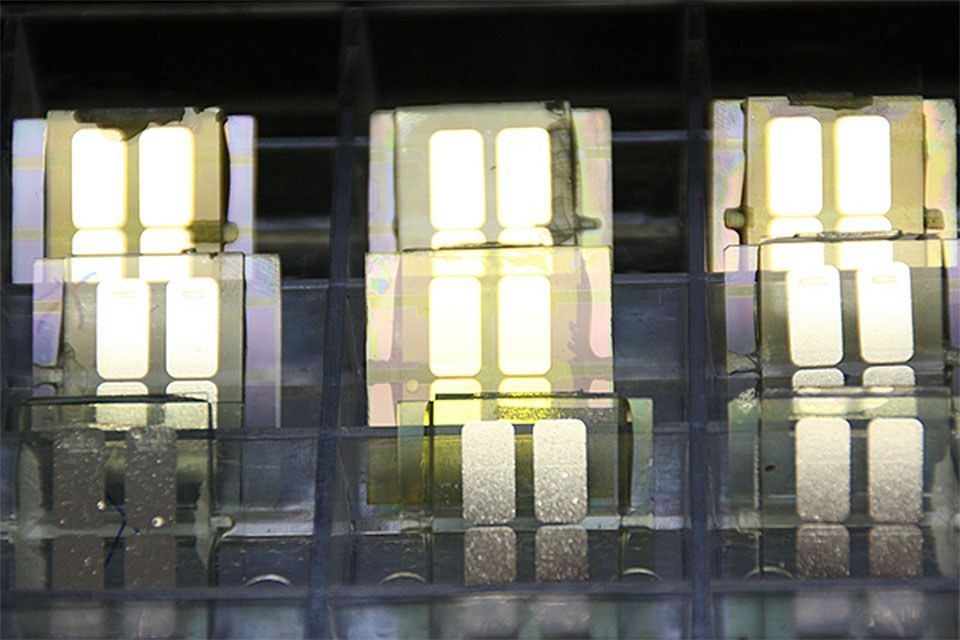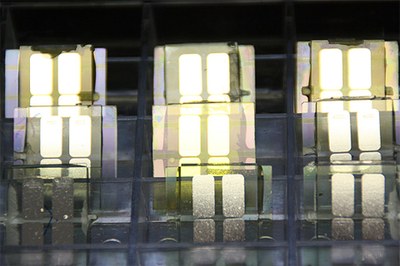Project cyFLEX Launched to Develop OLED-Based Luminescent Packaging
cynora GmbH and the Karlsruhe Institute for Technology (KIT) jointly announce the successful launch of Project cyFLEX. Organic light-emitting diodes (OLEDs) will serve as a basis for generating flexible and luminescent surfaces for smart packaging and advertising applications. Self-luminous packaging and ultrathin flexible advertising panels for all kinds of products may soon become reality and will revolutionize product marketing.
The purpose of the cyFLEX joint project is to develop viable OLED materials for mass-market applications that can be integrated into luminescent packaging for all types of products. Readily available source materials, such as copper, and new, efficient OLED manufacturing processes will help get luminescent packaging to market soon. The consortium formed by the German enterprise cynora GmbH and the Light Technology Institute at KIT will cover the value chain from material development all the way to the finished component. The project will explore ways of adapting OLED materials for efficient printing and coating processes as well as optimizing the manufacturing process for OLED components. Working closely together with the leading-edge cluster Forum Organic Electronics, the plan is to complete a small volume production run of printed flexible OLED film at InnovationLab GmbH (iL), a regional research and knowledge transfer platform. The project will draw on the cluster’s expertise in the field of printed organic electronics to successfully combine material and process development in one application.
cyFLEX will run with a timeline of two years and a budget of 619 000 EUR given to cynora GmbH, from which 309 000 EUR is financed by the Federal Ministry of Education and Research (BMBF – Bundesministerium für Bildung und Forschung).
Just how cyFLEX will facilitate OLED manufacturing is explained by Dr. Thomas Baumann, Managing Director of cynora GmbH: “The basic structure of OLEDs consists of several nanometer-thin layers that are progressively applied to flexible substrates, such as plastic film, using special printing processes. One of the areas that the cyFLEX project will focus on is transferring OLED materials to suitable printing and coating processes. The next step will then be to develop solution-processable OLEDs that could then be used in packaging printing.” This would make it possible to have packaging with luminescent and animated images, logos and text – and spark new impulses in product marketing. “Also conceivable would be to activate the luminescent effect as the customer approaches the packaging, drawing his or her attention to the product even more effectively,” says Dr. Norman Michaud of the KIT’s Light Technology Institute, describing the possibilities for applications.
A host of diverse applications for OLEDs:
In the areas of lighting and displays, OLED technology has already long been the subject of intense interest on the part of major high-tech companies. Brands like Samsung have begun integrating OLED Technology in high volumes for their displays in smartphones and digital cameras for some time now, and lighting specialists Osram and Philips are marketing their own OLED lamp products as well.
OLEDs, which consist of organic semiconductors, are self-emitting flat light sources with a thickness of only a few nanometers. In the fast-paced market for displays, OLEDs are playing a key role in a revolutionary development by making it possible to achieve bright color effects in thin and potentially transparent displays.
The packaging industry – which always tries to come up with effective solutions to address fundamental issue such as: How can I set my product apart from its competitors at the point of sale? How can I draw attention to my product? – has in recent years been closely following the evolution of OLED technology for use in modern packaging that uses lighting and moving images, texts and logos. Project cyFLEX could open completely new possibilities for product marketing and bring about sweeping change to the retail sales environment as we know it.
About cynora GmbH:
Founded in 2003, cynora GmbH came under new management in 2008. The company’s focus is on researching innovative organic semiconductors whose physical properties as illuminants destine them for applications in organic light-emitting diode (OLEDs). From designing new functional modules for OLEDs to manufacturing these components in a lab environment, where they are tested for physical suitability with advanced measurement methods and technology , cynora covers the entire spectrum of material and component development. Besides exploring new ways of achieving additional efficiency gains, the young and dynamic team behind cynora, currently numbering 22, also works on improving key aspects of OLED applications, such as cost-effective processing and life expectancy.
Printing optoelectronic components requires new, intelligent materials and approaches. Resulting products can be used as displays, light sources, design objects and solar cells for energy generation.
For further information: www.cynora.com
About KIT:
The Karlsruhe Institute of Technology (KIT) is a public corporation governed by the laws of the State of Baden-Württemberg. It pursues the mission of a university as well as that of a national research center that is part of the Helmholtz Association (Germany's largest scientific research organization). Research foci include energy, environment as well as society and technology, from fundamental aspects all the way to applications. With close to 9,000 employees (including 6,000 in research and teaching), and 24,000 students, KIT is one of Europe’s largest research and teaching facilities. KIT operates along the three strategic fields of action of research, teaching, and innovation.
For further information: www.kit.edu
About InnovationLab:
InnovationLab GmbH (iL) is a combined, application-oriented platform for research and knowledge transfer in science and business in the Rhine-Neckar metropolitan region. It is supported by the Universities of Heidelberg and Mannheim, the Karlsruhe Institute of Technology (KIT) and by the companies BASF SE, Merck KGaA, Heidelberger Druckmaschinen AG and SAP AG.
For further information: www.innovationlab.de


